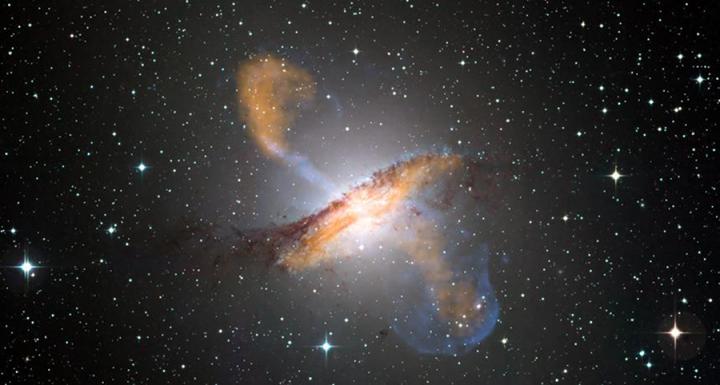Supernovas help 'clean' galaxies

Jets erupting from a supermassive black hole, such as the one in Centaurus A (shown in this color composite image), might clear the way for supernovas to sweep out gas and stop star formation. Photo credit: WFI/ESO (optical); A. Weill et al/APEX/MPIFR and ESO (submillimeter); R. Kraft et al/ CXC/CFA and NASA (X-ray).
Supernovas just might be the maid service of the universe.
It seems these explosions that mark the end of a star's life work hand-in-hand with supermassive black holes to sweep out gas and shut down galaxies' star-forming factories.
Recent research, led by Michigan State University astronomers, finds that the black holes located at the cores of galaxies launch fountains of charged particles, which can stir up gas throughout the galaxy and temporarily interrupt star formation.
But unless something intervenes, the gas will eventually cool and start forming stars again.
One mega-outburst from the black hole, though, could heat the gas surrounding the galaxy enough to let supernovas take over and mop up the mess. A celestial cleaning partnership might help astronomers understand why some massive galaxies stopped forming stars billions of years ago.
“Our previous research had shown that black-hole outbursts can limit star formation in massive galaxies, but they can't completely shut it off,” said team leader Mark Voit, MSU professor of physics and astronomy in the College of Natural Science. “Something else needs to keep sweeping out the gas that dying stars continually dump into a galaxy, and supernova sweeping appears to work perfectly for that.”
Other members of the research team are Megan Donahue, MSU professor of physics and astronomy; Brian O'Shea, MSU associate professor of physics and astronomy; Greg Bryan, Columbia University professor of astronomy; Ming Sun, University of Alabama in Huntsville assistant professor of physics; and Norbert Werner, Stanford University research associate.
This research was recently published in Science News and Astrophysical Journal Letters.
Media Contact
All latest news from the category: Physics and Astronomy
This area deals with the fundamental laws and building blocks of nature and how they interact, the properties and the behavior of matter, and research into space and time and their structures.
innovations-report provides in-depth reports and articles on subjects such as astrophysics, laser technologies, nuclear, quantum, particle and solid-state physics, nanotechnologies, planetary research and findings (Mars, Venus) and developments related to the Hubble Telescope.
Newest articles

NASA: Mystery of life’s handedness deepens
The mystery of why life uses molecules with specific orientations has deepened with a NASA-funded discovery that RNA — a key molecule thought to have potentially held the instructions for…

What are the effects of historic lithium mining on water quality?
Study reveals low levels of common contaminants but high levels of other elements in waters associated with an abandoned lithium mine. Lithium ore and mining waste from a historic lithium…

Quantum-inspired design boosts efficiency of heat-to-electricity conversion
Rice engineers take unconventional route to improving thermophotovoltaic systems. Researchers at Rice University have found a new way to improve a key element of thermophotovoltaic (TPV) systems, which convert heat…



